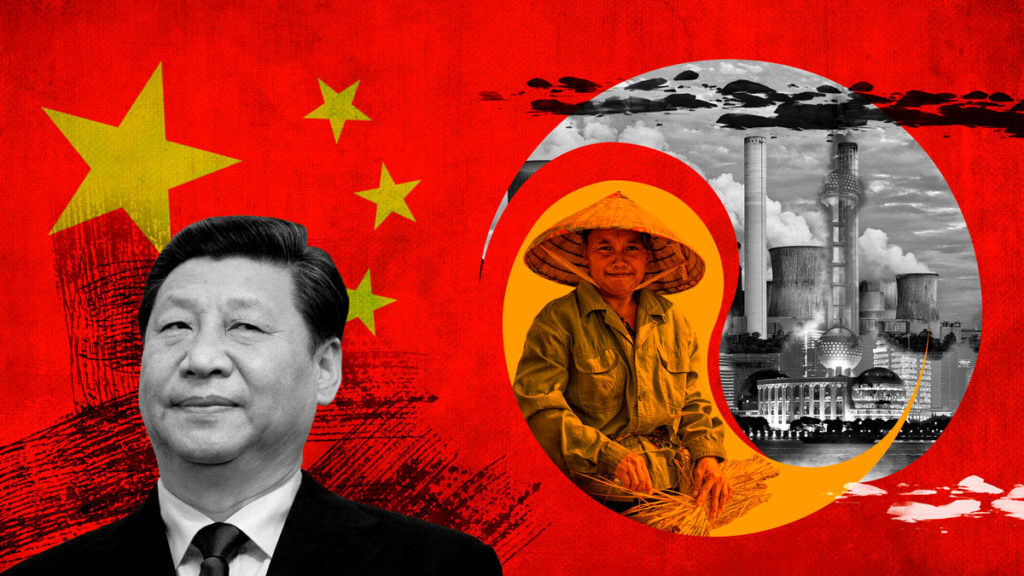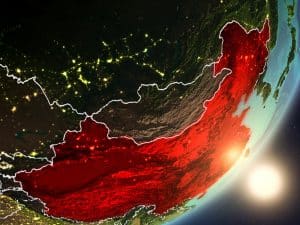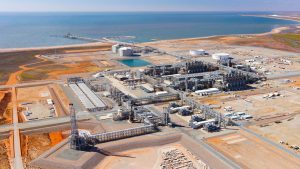The question of China’s place in the international order is central to characterizing where the capitalist world system is headed. It has been the subject of a debate in which we find quite divergent positions — a sign of its complexity. This article is part of a process of elaboration and discussion underway in the Trotskyist Fraction–Fourth International. The views expressed herein are those of the author alone.1I am especially grateful for Paula Bach’s contributions to the method and criteria that have allowed me to think about and characterize China’s current position in a balanced way.
China’s subordinate and marginal place in the world order has changed dramatically since the 1980s. Back then, the only thing exceptional about China’s international position was its importance to U.S. imperialism in its strategy against the Soviet Union. Since the 1990s, and especially since 2001, when China joined the World Trade Organization, the country has become an epicenter of superprofits for the multinationals of all imperialist countries. This transformation allowed China to establish itself as an exporter of finished goods or labor-intensive components, and then to assume increasing international influence through trade and diplomacy, all the while concentrating its internal efforts on making its economy more complex, increasing local value added, and competing for leadership in innovation. This process unfolded over successive stages of capitalist restoration, which took place within the framework of the Chinese Communist Party (CCP) regime, in which the state retained broad powers that remain central to directing both the economy and social organization. China thus combines statism with its leading role in the global flow of capital. This “hybridization” is a distinctive feature of the unequal and combined development that today characterizes the Chinese economic and social formation. Both facets are fundamental to understanding China’s peculiar path, which has differed from that of any other dependent or semicolonial country.
In the last 20 years, China has deepened the economic relations that have made it one of the main commercial partners of nearly every country on the planet. It has, meanwhile, sought to establish its own sphere of influence and economic presence. It has done so through bilateral trade, investment, and diplomatic agreements, and even by installing security-related infrastructure (such as its space station in Neuquén, Argentina). During the first decade of this millennium, its efforts to expand its global influence took place within the framework of its codependent relationship with the United States, which led to talk about “Chinamerica.” Many U.S. analysts worried about “global imbalances” — meaning, in essence, the United States’ trade deficit, with China and its resulting dependence on China for financing. There was also lots of talk about currency “manipulation.” But there were still no signs of a U.S.-China rupture.
That began to change after 2008. Under President Obama, who in 2011 announced the “pivot to Asia,” relations with China became more tense. That spurred a more interventionist response from China, especially when Xi Jinping came to power in 2013. Since then, confrontation has increasingly prevailed in U.S.-China relations, escalating under Trump. But the strong mutual dependence remains unchanged between China, the main exporter, and the United States, the world’s great buyer. This complicates the conflict’s development.
At the same time that there are objective and incontrovertible indicators that China’s international influence is growing. These signs coexist with contradictory signs showing that China remains in a subordinate role within world capitalism.
If we draw a parallel with the period when the United States began to replace England as the world’s hegemonic power, we will see many differences between China’s position today and that of the United States at that time. These contrasts are what make China so difficult to characterize. As we think about the similarities and differences, it is interesting to read Leon Trotsky’s observations in various articles and speeches on the decline of England and the rise of the United States.2See, for example, “Sobre la cuestión de la ‘estabilizacion’ de la economia mundial” [On the question of the “stabilization” of the world economy], a 1925 speech published in El capitalismo y sus crisis [Capitalism and its crises] (Buenos Aires: IPS, 2008). In her prologue to the book’s first edition, Paula Bach also takes up Trotsky’s texts as key to thinking about the similarities and differences between the U.S.-England relationship at that time and that of the United States and China during the 2008 crisis, focusing especially on the monetary question and China’s becoming a major lender to the main imperialist power. Back then, both the United States and Germany — two countries in the throes of an interimperialist dispute — had clearly surpassed Great Britain in the development of productive forces. China, however, was a combination of modernity and backwardness, resulting from the accelerated pace at which it had taken its “leap of stages.”
No less today are China’s differences with the other powers that have ascended to the world stage. The United States created the basis for its rise over a more than 100-year period that included protectionist policies for its industrial base, cotton production, and the conflict between the slave South and the Northern liberal “consensus.” The Civil War consolidated the basis for the U.S. takeoff. China did this in 40 years, appealing to imperialist capital — which explains why the imperialist multinationals have such a prominent, and even dominant, place in China’s foreign trade to this day.3Multinationals’ domination of China’s foreign trade is not total, given that state representatives and observers play a prominent role in many private companies, including even in foreign firms, which they have had to tolerate. Further, value chains and world trade growth have stagnated during the last decade, reducing their relative importance in China’s economy as a whole, especially as investment in infrastructure and real estate development have become more important. But we cannot look only at the “negative” aspect of foreign domination, or China’s ongoing dependence. We must also see how China’s dependence has enabled the CCP’s leading strata in its aspirations, thanks in large part to the “control” that the Chinese state has maintained. Foreign domination has, in short, made possible China’s “climb” up the development ladder, despite the enormous inequalities that inevitably resulted from China’s accelerated developmental “leap of stages.”
Most analyses of China’s place in the world involve two intertwined discussions, which we must try to separate. The first concerns how China positions itself within the “community of nations,” that is, the extent to which it already sees itself as a power. The second centers on whether China is vying for global leadership. These two issues are confounded, and when analysts gauge China’s position relative to the dominant United States, they often discard the idea that China might be becoming an imperialist power. But if we instead consider China relative to the other imperialist countries, exploring several other factors, we will come to a different conclusion. China is well behind the United States, but it is beginning to surpass the other imperialist countries in many respects — even with its many weaknesses, including heterogeneities in its economic structure.
On the one hand, as we consider multiple dimensions together, it is increasingly difficult to say that China has not already become an imperialist country on par with some of the world’s most powerful — excluding, of course, the United States, with which China cannot be compared. On the other hand, China remains a dependent country with economically backward regions, making it unthinkable to characterize it as imperialist — at least for now. Nevertheless, within the framework of these two persisting contradictory tendencies, China’s direction seems clear.
1. The Quantitative Dimensions of China’s Position Today
To establish China’s place in global power relations, and to assess its progression, we must examine China’s economic indicators, military status, and the parameters of its global position.
Economic Indicators
The parameters proposed here may have some limitations. Everything related to China takes on such a scale that it alters any parameter. Consider, for example, that China is the world’s second-largest economy in terms of GDP, but that it has a relatively low level of GDP per capita, or productivity. An economy’s size is a major factor in its weight on the international scale, but as Trotsky remarked, “The law of the productivity of labor is of the same significance in the sphere of human society as the law of gravitation in the sphere of mechanics.”
In capitalism’s history over the last two centuries, the countries that have competed for world leadership were always those in the forefront of productivity. What makes China peculiar is that this has not entirely happened. Yes, its hourly productivity increases over 40 years are a record unmatched by most countries, expressing the magnitude of its transformation. But even so, there is a veritable chasm between its hourly productivity and that of the other imperialist powers: China’s productivity is only 20 percent of that of the United States and Germany, and 32 percent of Japan’s. Of course, part of this is obvious: the gigantic Chinese population makes per-person productivity much lower. The scale of China and its heterogeneity can fool us: the country’s southeast region, where China’s “Silicon Valley” is located, has high productivity, but this is averaged in with the low productivity of the peasant regions, and from that aggregate comes the very low “total productivity.” Even so, the measure shows the road that China still must travel. Note the rather sweeping trend: in 2007, China’s hourly productivity was 10 percent that of the United States, which means that since then the proportion has doubled.4All productivity data are taken from the Conference Board’s international database.
From this heterogeneity in productivity and low per capita wealth, there results a class structure with no comparison in any imperialist country. Statistics do show a growth in the social strata that conventional sociology categorizes as “middle class” — that is, a population of wage earners, independent tradespeople, and professionals who can afford to consume a certain amount. But 68 percent of the Chinese middle class “falls into the lower-middle income category.”5China Power Team, “How Well-Off Is China’s Middle Class?,” China Power, April 26, 2017, updated October 29, 2020.
China is a country out of scale. The effects of this are manifested in 2020’s Fortune Global 500 list, in which most of the world’s largest corporations are, for the first time, Chinese based. Of the 500, China has 119, followed by the United States, with 99. This is traditionally a sign of a country’s economic power: how many companies it has among the largest. At least in the last 90 years, this measure has been indisputably dominated by the United States China first came to the fore in 2019, but it has more firms mainly because its economy is so large and because policy strengthens “national champions.” But when it comes to these firms’ influence, the United States — even with fewer firms — still has the upper hand. For every Huawei that competes globally, there are five Chinese firms in the ranking with few businesses outside the country. For the United States, Japan, and the European Union, almost inverse is true: these countries’ Global 500 firms have widespread international business and dominate either global value chains or international finance. The same is true when we look at “economic performance”: the 99 U.S. firms are more profitable, and use fewer assets, than the 119 China-based firms.
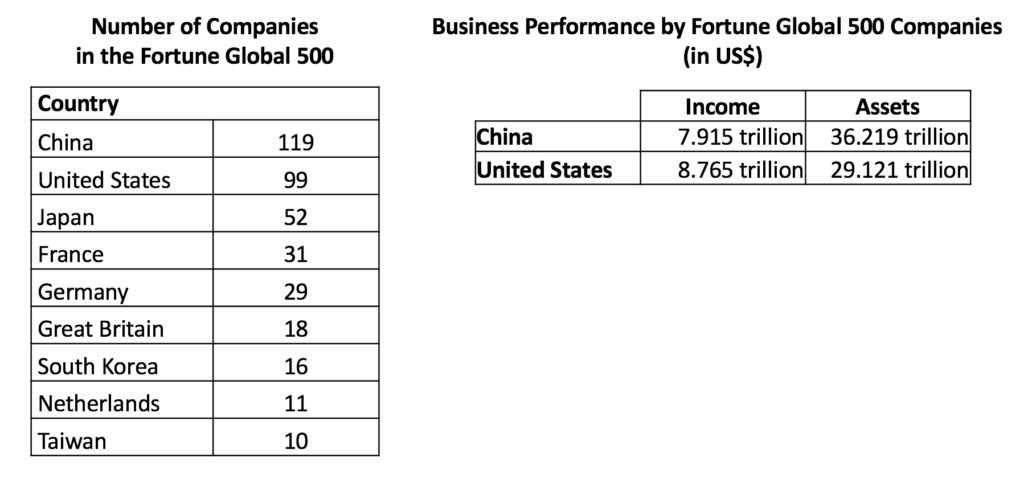
This is, nonetheless, a strong indicator that Chinese corporations are undergoing significant development, a trend that is led, of course, by state-owned companies, as well as some important private firms that are expanding significantly and enjoy competitiveness.
Closely related to all this is the position of various countries in the technology race. The technology leaders can dictate what other countries produce and how they produce it, thereby dominating the strategic links in the value chain — those that generate the lion’s share of wealth — and eventually also realize income from the ownership of technological patents.6For more on this topic, see “New Technologies, TikTok, Competition, and ‘Free’ and Human Labor: An Interview with Economist Paula Bach,” Left Voice, September 19, 2020. I developed this in more detail in a recent article: a summary follows. In 2019, China was, for the first time, the largest user of the international patent system, followed by the United States, Japan, Germany, and South Korea. According to the 2019 European Commission rankings of the world’s 2,500 firms that invest the most in research and development (R&D), China has the second-most companies after the United States, and is followed by Japan and Germany.7European Commission, Joint Research Centre, The 2019 EU Industrial R&D Investment Scoreboard (Luxembourg: Publications Office of the European Union, 2020). All data in this paragraph are extracted from this document. But when it comes to spending, China is relegated to third place: U.S. firms spend 312 billion euros, Japan’s 109.4 billion euros, and China’s 96.4 billion euros. Germany’s investment in R&D is quite close to China’s — 82,900 million euros — even though Germany has only a third of the firms that China has, at 2,500. China has many firms in the ranking, but only two in the top 50: Huawei (fifth place) and Alibaba (28th). The United States has 22 in the top 50; Germany, 8; and Japan, 6. Korea has only one, but it is Samsung, which ranks second in terms of R&D spending in 2019.
The United States thus continues to lead in this area, followed far behind by Japan, China, and Germany. Huawei and Alibaba have allowed China to stake some territory, and there are sectors, such as 5G and artificial intelligence,8See Kai-Fu Lee, AI Superpowers: China, Silicon Valley, and the New World Order (Boston: Houghton Mifflin, 2018). The book provides an overview of the relative strengths of the United States and China in different dimensions of AI development. in which head-to-head competition is beginning to emerge. But the United States remains considerably ahead in terms of resources invested in innovation development. The rest of the countries, even those with highly developed technology, such as Germany, are starting to watch the race from behind.
The international expansion of companies through foreign direct investment (FDI) is another sign of economic power. Until a few decades ago, capital export was the exclusive preserve of the imperialist countries, but today many “emerging” and “developing” countries also export capital; that is, their residents make direct foreign investments. For this reason, the hierarchy of countries today does not depend on whether they export capital but on the amount of such exports and the net result between “exported” capital and capital received.[]Esteban Mercatante, “Uneven Development and Imperialism Today: Engaging with the Ideas of David Harvey,” Left Voice, September 13, 2020.]] Here we can see the extraordinary expansion of China that has taken place in just 20 years.
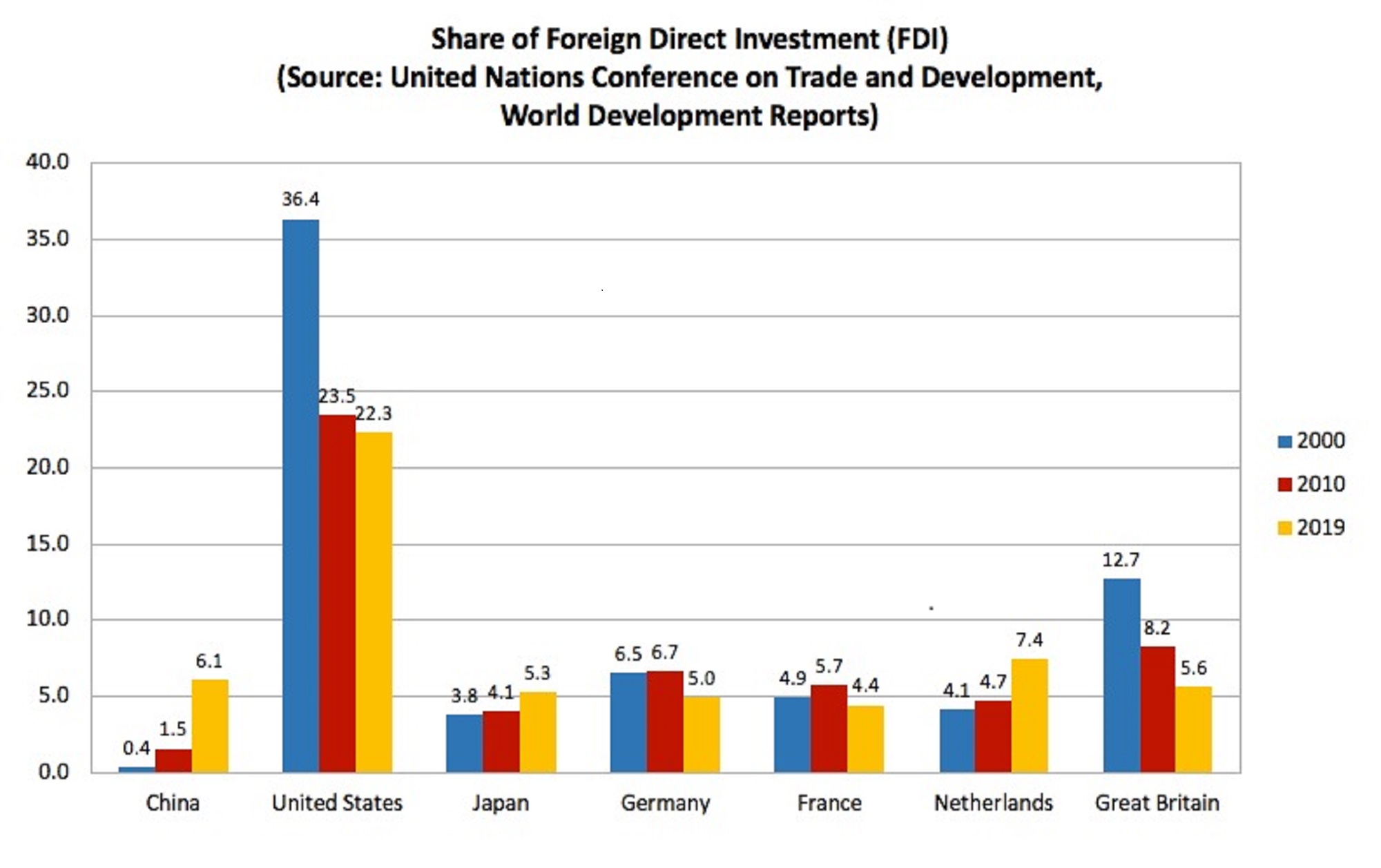
In 2019, China ranked third in FDI among countries; its FDI represented 6 percent of the global total stock. Just 19 years earlier, its FDI represented a mere 0.37 percent. The United States remains the largest global investor by far, although from 2000 to 2019 its share of the total fell from 36 to 22 percent. U.S. FDI is still more than three times that of the Netherlands, which ranks second. Great Britain, Japan, Germany, and France are slightly behind China in terms of the volume of productive capital they export. But, unlike China, all except Japan and the Netherlands have seen their shares fall from what they were nine or 19 years ago. Only China has shown an exponential growth in FDI.
As is often the case with several imperialist countries, but not most dependent economies, FDI from Chinese residents abroad exceeds that of foreign capital in China. In the last few decades, China has been a pole of attraction for capital from around the world, especially the big multinationals that established an important part of their value chains there, but with the investments that China’s companies — especially state-owned ones — have been making in other countries, the country has come to have more capital exported than coming in, although both amounts are huge. In other words, it is a net “creditor” to the rest of the world in terms of productive capital. This differentiates China from the United States, which takes in more FDI from other countries than it invests abroad — that is, the United States has accumulated a fairly significant “debtor” balance (comparing only productive investments, not the entire net position of the external accounts that are also chronically in deficit for the United States).
The Belt and Road Initiative, as well as investments aimed at securing privileged access to natural resources, constitute separate elements of China’s capital export and international economic expansion. China has poured everything into this race. In Africa it has gained advantageous positions in many countries compared to the United States and the European powers, and at the same time it has more than once displayed behaviors that are quite reminiscent of traditional colonialism in terms of its rapacity and disregard for environmental impacts.
One of China’s weakest pillars thus far is in the expansion of its financial power, understood as the reach of its currency as an international currency and the internationalization of its financial system. There is no need to delve too deeply into the power that accrues from managing global finance. Economic sanctions, which have become increasingly important in Washington’s arsenal of policies to strike back at countries that challenge the United States, play a fundamental role in the financial sphere. Because of the centrality of the dollar and the U.S. financial system in international finance, the U.S. government can block residents of other countries from using dollars in commercial and financial transactions; freezing assets is easy to do and very effective in striking at a country’s political and economic elite. Financial power also enhances firms’ capacity to accumulate capital and expand globally when operating in that country. In this area, the United States has a clearly overwhelming advantage. New York is the center of global finance, and the dollar dominates commercial and financial transactions: in daily foreign exchange operations, 88 percent of turnover involves the dollar on one side of the transaction. In comparison, the euro accounts for only 32 percent; China’s currency, the renminbi, is only 4 percent (the total amount traded is 200 percent because it takes into account the currencies on both sides of the transaction).
China has been trying to gain ground, seeking to replace the dollar with its currency in trade. Any effort to substantially change the balance between currencies, however, is limited by the fact that only 7 percent of foreign exchange transactions are made by nonfinancial companies, that is, those more directly linked to trade. By trading with the renminbi, which it cannot do with all countries, China can increase its standing in this arena, but the remaining 93 percent is linked to financial transactions. China is also committed to developing its own financial scaffolding. With the currency swaps carried out between the People’s Bank of China and the central banks of other dependent countries, it is weaving ties that favor increasing the international gravitation of the renminbi. The most ambitious initiative in this arena has been the creation of international financial institutions involving other countries, with a preeminent place for China: the Asian Infrastructure Investment Bank (AIIB), launched by China in 2013–14, and the BRICS Development Bank, now called the New Development Bank (NDB), proposed in 2013–14 and launched in 2015. The NDB has not been very active, because the BRICS countries have drifted apart,9Translator’s note: BRICS refers to five major emerging national economies — Brazil, Russia, India, China, and South Africa — that have met annually at formal summits since 2009. Brazil becoming more aligned with the United States and India confronting China in border disputes. Meanwhile, the AIIB, with US$100 billion in capital and more than 100 member countries to date, has financed electricity, energy, and road projects in the Philippines, Bangladesh, Pakistan, India, Indonesia, Egypt, Turkey, and elsewhere.
Military Power
As in the financial arena, the U.S. military remains well ahead of all other countries’ militaries, including China’s. U.S. military spending in 2019 accounted for 38 percent of the global total, according to the Stockholm International Peace Research Institute. China spent just over a third of what the U.S. disbursed, ranking second, with 14 percent of the global total. The military capabilities developed as a result of these levels of investment exceed those of several imperialist countries.
There are some areas, such as the nuclear warhead arsenal, in which the United States — and Russia — have overwhelming superiority, with 6,800 compared to China’s fewer than 200. But in others, China has quickly built up considerable advantages. According to one recent report, China developed “a world-class weapons and shipping industry.” Chinese weapons manufacturers “excel in artificial intelligence and in the production of drones and missiles.” According to Western intelligence estimates, Beijing has deployed at least 2,000 land-based missiles, conventional and nuclear, with intermediate ranges (from 500 to 5,500 kilometers).
China is also making strong progress with its Navy. As a Congressional Research Service report notes, “China’s navy is, by far, the largest of any country in East Asia, and within the past few years it has surpassed the U.S. Navy in numbers of battle force ships.” According to the same report, the Naval Intelligence Office says that China will have 360 combat ships by the end of this year, compared to 297 for the United States. China’s navy “is viewed as posing a major challenge to the U.S. Navy’s ability to achieve and maintain control of blue-water ocean areas in the Western Pacific — the first such challenge … since the end of the Cold War.”
A key distinction is that so far, unlike the United States and other imperialist countries, China has not used its military force in large-scale interventions in areas that are not linked to conflicts with neighboring countries or threats to its maritime territory.
The “Quantitative” Parameters and China’s Global Position
To draw some conclusions from the foregoing analysis, we should take the factors discussed above as a whole and consider what they tell us about China’s comparative position vis-à-vis other countries. Tony Norfield does this in his Index of Power Update (based on China’s GDP, foreign investment, the weight of its banks, its currency, and military power).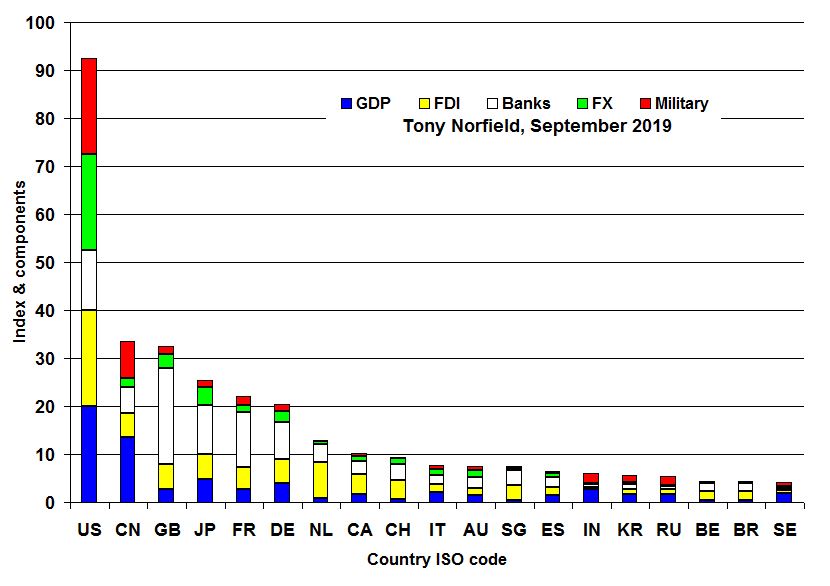
China moved to second place for the first time in 2019 — the top spot is the United States, of course — followed by Great Britain, Japan, France, Germany, and the Netherlands. A closer look reveals that China’s difference concerns the size of its GDP and its military power. In the other dimensions Norfield measures, it ranks almost the same as the countries that follow it, or slightly behind. One crucial aspect that is not covered by this indicator, but that should be highlighted, is innovation. In this area, China has been gaining ground and competing near the top, as pointed out earlier, so including it would reinforce China’s position in the index.
Norfield does not consider China imperialist, because in his opinion the county’s capitalist developments have not qualitatively altered its social structure or the state’s conduct. He also assigns to China — erroneously — a progressive role both for its social achievements and its achievements as a “counterweight” to the imperialist powers. I do not share these arguments because of what I develop in this and other articles.
One considerable difference between China and the imperialist countries that leaves it behind in the competition for global power is the greater “consistency,” so to speak, in the position of those other countries. With respect to Japan, Germany, Great Britain, and France, their positions are more or less consistent in terms of wealth generation, expansion of transnational capital based on that, capacity for innovation, and development of finance and currency — beyond any specific advantages that each country may have (such as the undisputed advantage that the City of London gives Great Britain, or, for example, the leads Germany and Japan enjoy in innovation). The same is true in the military arena, with the exception of Germany, which is behind on this point. Conversely, China projects great power thanks to its huge scale and strength in certain areas, but this contrasts with the country’s inability to completely eradicate some dependent traits and its economic and social structure, which is plagued with heterogeneities.
2. Weak Points
This examination of the relative position of China must, finally, introduce some other critical dimensions that show the most vulnerable points of China’s position.
Incomplete National Unity
As long as China’s territorial integrity remains unresolved, it cannot be a successfully advancing imperialist construct. The geopolitical unity achieved by the 1949 revolution, a watershed moment, has always been incomplete, since China had to live with the British occupation of Hong Kong and the Portuguese occupation of Macao, which lasted until 1999, and with the protectorate constituted by the Kuomintang in Taiwan.
Taiwan poses a fundamental security problem, since its demand for independence has always had imperialism’s support, open or implicit. U.S. policy toward Taiwan has been described by some analysts as a “strategic ambiguity”: even though every president since 1979 (even Trump, who flirted with a reversal) has maintained no formal diplomatic relations with Taipei, the U.S. Congress maintains in force the Taiwan Relations Act, which promises to supply defensive weapons to Taiwan, emphasizing that any attack from China would be of “grave concern” to the United States.
As for Hong Kong, the persistent conflicts of the “one country, two systems” scheme have sharpened in recent years. Because of its financial ties with London, Hong Kong is a central channel for moving capital, and it could become an Achilles’ heel if recent clashes continue to deepen.
Owing to the heterogeneity of China’s productive and social structure and its inability to dominate these territories, there exist multiple Chinas, and for the Chinese state this is potentially destabilizing, undermining any projection of global power.
Lack of Mechanisms to Protect Economic Interests Abroad
Imperialism, by definition, means that a state expands its economic interests beyond its borders. This, in turn, implies the submission — formal or informal — of other territories to ensure that imperial interests are protected and to ensure the flow of profits and income that derive from the imperial relationship. At the end of the 19th century and the beginning of the 20th, each imperialist power exercised this “police power” to defend its capital in its colonial territories. The same was true of the semicolonies, which were subordinated with varying degrees of formal political sovereignty. But at the end of World War II, the struggles against colonialism forced the colonial powers to give up almost all their overseas territories. At the same time, U.S. imperialism came to the defense of global capital and its interests, assuming the role of “policeman” to ensure worldwide compliance with rules favorable to capital accumulation. The United States “arrogated to itself the sole right to intervene against other sovereign states (which it repeatedly did around the world), and largely reserved to its own discretion the interpretation of international rules and norms.”10Leo Panitch and Sam Gindin, The Making of Global Capitalism: The Political Economy of the American Empire (London: Verso, 2012), 12. The United States plays this role of global policeman to defend the interests of those countries that have agreed to remain integrated into the U.S. security orbit and system of alliances. Doing so, even in the case of imperialist countries, meant a certain degree of subordination. Countries such as China are outside this sphere.
China does not yet have military or diplomatic capabilities equivalent to those that the United States has developed. Such capabilities, by extension, favor the imperialist powers that still operate within the framework of “Atlanticism” — even though a longstanding and enormous crisis has dragged down this postwar structure. Hence, Beijing cannot stop countries from repudiating their debts, nor can it effectively use sanctions when other states renege on their commitments. China’s great threat is to close its market to those that do not comply and, increasingly, to shut down financing. But this “soft power” is not always enough, especially when tensions escalate with the United States — which also acts, both directly and through its allies, on those same countries. A good example of this lack of effectiveness can be found in the changing in positions regarding 5G technology.
How Appealing Is the “Chinese Way of Life”?
One of the most enduring points of support for U.S. “hegemony” has been its promise of “exporting” the “American way of life.” Could China achieve equivalent influence by virtue of its “way of life”? The Economist warned recently against underestimating China’s ability to present its model of “state capitalism” as successful, a model that has been combining high growth and rising per capita wealth — from very low levels — with some resounding successes in innovation and competition. But this does not seem sufficient to elevate China to the U.S. position. “Socialism with Chinese characteristics,” as the bureaucracy continues to refer to its development scheme, has been defined from the beginning as a peculiarity. The CCP’s bureaucratic regime was a key element in China’s exceptional rise, and it continues to consolidate that rise, thus sustaining the contradiction between capitalist development and state enterprises, managing the levers of credit in favor of economic growth, and directing innovation toward strategic sectors. But this also keeps the “Chinese way of life” from challenging the United States’ ideological hegemony. Because the CCP and its Bonapartist regime play a critical role in Chinese development, it is neither reproducible outside China, nor can it be presented as a pole of attraction.
The Chinese regime’s Bonapartist characteristics, reinforced by Xi, quite broadly limit the Chinese model’s prospects for hegemony. The appeal to aspects of more traditional ideology, which go hand in hand with a growing “stressing of the uniqueness of the Chinese civilization and the notion of proud nation framework-building during the Xi era,”11Kerry Brown and Una Aleksandra Bērziņa-Čerenkova, “Ideology in the Era of Xi Jinping,” Journal of Chinese Political Science 23, no. 3 (2018): 323–39. seeks to fill this gap, but it cannot expand beyond the country’s borders.
In the competition for global leadership and ascendancy over other countries, China could, for a moment, take the place ceded by the United States and present itself as a champion of “globalism.” With Trump proclaiming “America First” and attacking globalization in all his speeches, Xi put himself forward as the guarantor of economic integration. In every world forum and meeting of an international organization, almost all formed at the behest of the United States, China was advancing and became a prop as Trump turned his back on the country or expressed his disdain for it. The greatest gift in this sense was the United States’ abandonment of the Trans-Pacific Partnership, which Obama had negotiated by bringing together more than a dozen countries as trading partners, excluding China. When the United States pulled out, China expressed an interest in joining and could have become the treaty’s main beneficiary. But with Biden, the Democrats will try to return to a more globalist agenda — although there are deep reasons that this orientation will find limits and it will be more complicated for China to continue to occupy the place Trump vacated.
3. Some Conclusions
What does the analysis of these contradictory dimensions tell us? Some authors, such as Au Loong-Yu Au12See, for example, “China’s Rise as a World Power: Loong Yu Au Interviewed by Ashley Smith,” International Socialist Review 112 (Spring 2019). See also Juan Cruz Ferre, “Strength and Contradictions of the Chinese Economy: An Interview with Au Loong Yu,” Left Voice, September 13, 2018. refer to China as an imperialism in the process of construction or constitution, but one that has yet to be consummated. This could best characterize China’s current position. But it is important not to give the sense that this process will inevitably take shape. It is surrounded by multiple threats, both because “many Chinas” exist as a result of inequalities in production and because capitalist development creates deep tensions — namely, discontent among those who continue to resist the process and among those who complain that it isn’t happening quickly enough. Beyond whatever the future may hold, “imperialism under construction” does account for China’s place today. By many objective measures, China is ahead of some of the main imperialist powers, although far behind the United States.
A characterization of this type allows for clarifying China’s role in the world capitalist order. China does not contest the exploitative character of that order; instead, it has taken advantage of it internally by handing over the labor of hundreds of millions of workers to exploitation by imperialist and local capital, favoring capital throughout the world to execute a global arbitrage against its workforce to increase profitability. In its relations with other countries, China reproduces patterns of pillage and plundering like those of the European powers and the United States. It is wrong, then, to suppose that China can be a benign counterweight to imperialist pillage, a global power but not an imperialist one. China can be a counterweight to other powers by providing financial assistance and making investments. But that happens because it has its own interests at stake, and that aid or counterweight comes at a high cost. Within its own borders, the Chinese state oppresses and denies even minimal rights to national minorities, employing the harshest sorts of repression. We have seen the most recent example in Xinjiang against the Uyghur people.
As noted at the beginning, two questions must be distinguished: Is China transforming itself into an imperialism? And can China be a hegemonic power? As has been shown, if reasons can be found for answering the first question in the affirmative, even conditionally, the second cannot even be seriously posed without raising the possibility of greater confrontation.
Despite the limits of China’s position, its ambition to strengthen the force of its gravitational pull internationally has been clashing with U.S. interests. China cannot advance beyond where it is now without turning the current tensions with the United States into a more direct clash. That is because China, although it does not subvert the imperialist order, is obliged to challenge those pillars of the present order, within which it has developed thus far, that favor the United States. To take center stage in the world power system, China cannot simply claim to replace the United States, because the networks of power that the United States has built put the United States itself at the center. Within the structure of alliances and the subordination of allies, the U.S. State Department coordinates with the Pentagon (despite tensions from time to time), the Treasury Department in financial matters, and the Federal Reserve as a line to the central banks of the most powerful countries. This undergirds the architecture of global governance required by transnational capital. That structure is sustained while it is used to reproduce U.S. power.
Nor can China be thought of as simply another “accommodating” subordinate power among others. It cannot simply continue to “rise” within a “borrowed” order, nor will the dominant U.S. power give up its place. Nor can we expect the imperialist countries that are already being relatively displaced by China’s rise to settle for this situation peacefully, although in a context of the more general dissolution of the postwar order we can expect more divisions and rearticulation of alliances. China can stir up rivalries or become a pole of attraction.
At the same time, one must always account for all the potentially destabilizing effects that the capitalist course has created in China. These could be its main Achilles’ heel — one the sharpening of international rivalries could intensify. Several sectors of the bureaucracy are wary of Xi’s ambition to extend his power longer than 10 years, which would mean breaking with a practice that has been in place since the departure of Deng. There are also wounds that have not fully healed, from disputes that preceded Xi coming to power and that ended with the takedown of Bo Xilai, the standard-bearer of a vaporous “neo-Maoism” who presided over the party in Chongqing and is now imprisoned, serving a life sentence. There is a structural reason for discontent among the sectors that have benefited most from the policies of capitalist integration: specifically, it is that despite the consolidation of bourgeois relations of production, the trend since Xi took office has been stagnation of the reform agenda and the strengthening of statism along with the regime’s more Bonapartist features.
From the point of view of the subordinate classes, the young proletariat that developed in the last decades — having little connection to the working class of the public enterprises that suffered heavy defeats because of privatizations — has in the last five years been leading processes of organization and struggle that have forced the regime and enterprises to grant better wages and working conditions.13These wage improvements were not only the result of struggle but were also part of the objective announced in 2008 of “rebalancing” the economy. But the increases granted were never enough to achieve the aspiration that internal consumption of finished goods would play a role in pushing economic growth. As the editors of the China Labour Bulletin have observed, “During the 21st century, collective protests by workers have become increasingly frequent and well-organized, to the point that they are now part of everyday life in China and labour unrest is deeply entrenched in Chinese society as a whole.”14“The Workers’ Movement in China 2015–2017,” China Labour Bulletin, August 2018. Xi’s accumulation of power also leaves him more exposed to setbacks and can trigger internal struggles that, in this context and given the external conflict, become unmanageable. The explosion of Covid-19 and the clumsy initial response to the outbreak at first threatened catastrophic consequences for the CCP’s dominance, but Europe and the United States’ relatively worse performance left the bureaucracy in a better position and allowed China to export aid. But it was yet another sign that Xi’s position — and that of the entire regime — is by no means stable. One cannot rule out a massive state crisis with catastrophic consequences for China’s position. China now has unprecedented levels of corporate, government, and household debt; together, they exceed 300 percent of GDP. The country is haunted by the specter of a tremendous economic crisis. State-owned, heavily leveraged companies could be among the hardest hit. These threats have so far been kept at bay by state control of the financial system, but at the cost of kicking the can down the road, since the country’s liabilities are constantly growing. Such a scenario could aggravate all the potential instabilities already mentioned to unbearable levels.
The open dispute between the United States and China is today focused on trade and which country will enjoy technological primacy — the latter a question that is closely linked to security considerations. Now, with growing certainty, the dispute threatens to devolve into a military conflict, and this threat is heightening all the internal tensions within China.
What must be clear is this: China cannot be characterized as imperialist in the full sense of the term. But when there is a clash between China and the United States, or any other imperialist power, we should not read this clash as code for “imperialist aggression against China,” which would dictate automatic support for the latter. Although China is challenged by imperialism, the state led by the CCP does not represent a progressive alternative to imperialist domination by the U.S. and its allies, as made clear by the experiences of the Chinese proletariat and China’s oppressed nationalities. Of course, each conflict must be defined by its concrete circumstances. But it is clear that from such conflicts there will emerge neither an alternative nor a toehold for the oppressed to cut the chains of imperialism and capitalist exploitation. On the contrary, the ambition of Xi Jinping and the entire CCP leadership is to make the Chinese state another brick in the wall.
First published in Spanish on November 15 in Ideas de Izquierda.
Translated by Scott Cooper
Notes
| ↑1 | I am especially grateful for Paula Bach’s contributions to the method and criteria that have allowed me to think about and characterize China’s current position in a balanced way. |
|---|---|
| ↑2 | See, for example, “Sobre la cuestión de la ‘estabilizacion’ de la economia mundial” [On the question of the “stabilization” of the world economy], a 1925 speech published in El capitalismo y sus crisis [Capitalism and its crises] (Buenos Aires: IPS, 2008). In her prologue to the book’s first edition, Paula Bach also takes up Trotsky’s texts as key to thinking about the similarities and differences between the U.S.-England relationship at that time and that of the United States and China during the 2008 crisis, focusing especially on the monetary question and China’s becoming a major lender to the main imperialist power. |
| ↑3 | Multinationals’ domination of China’s foreign trade is not total, given that state representatives and observers play a prominent role in many private companies, including even in foreign firms, which they have had to tolerate. Further, value chains and world trade growth have stagnated during the last decade, reducing their relative importance in China’s economy as a whole, especially as investment in infrastructure and real estate development have become more important. |
| ↑4 | All productivity data are taken from the Conference Board’s international database. |
| ↑5 | China Power Team, “How Well-Off Is China’s Middle Class?,” China Power, April 26, 2017, updated October 29, 2020. |
| ↑6 | For more on this topic, see “New Technologies, TikTok, Competition, and ‘Free’ and Human Labor: An Interview with Economist Paula Bach,” Left Voice, September 19, 2020. |
| ↑7 | European Commission, Joint Research Centre, The 2019 EU Industrial R&D Investment Scoreboard (Luxembourg: Publications Office of the European Union, 2020). All data in this paragraph are extracted from this document. |
| ↑8 | See Kai-Fu Lee, AI Superpowers: China, Silicon Valley, and the New World Order (Boston: Houghton Mifflin, 2018). The book provides an overview of the relative strengths of the United States and China in different dimensions of AI development. |
| ↑9 | Translator’s note: BRICS refers to five major emerging national economies — Brazil, Russia, India, China, and South Africa — that have met annually at formal summits since 2009. |
| ↑10 | Leo Panitch and Sam Gindin, The Making of Global Capitalism: The Political Economy of the American Empire (London: Verso, 2012), 12. |
| ↑11 | Kerry Brown and Una Aleksandra Bērziņa-Čerenkova, “Ideology in the Era of Xi Jinping,” Journal of Chinese Political Science 23, no. 3 (2018): 323–39. |
| ↑12 | See, for example, “China’s Rise as a World Power: Loong Yu Au Interviewed by Ashley Smith,” International Socialist Review 112 (Spring 2019). See also Juan Cruz Ferre, “Strength and Contradictions of the Chinese Economy: An Interview with Au Loong Yu,” Left Voice, September 13, 2018. |
| ↑13 | These wage improvements were not only the result of struggle but were also part of the objective announced in 2008 of “rebalancing” the economy. But the increases granted were never enough to achieve the aspiration that internal consumption of finished goods would play a role in pushing economic growth. |
| ↑14 | “The Workers’ Movement in China 2015–2017,” China Labour Bulletin, August 2018. |


